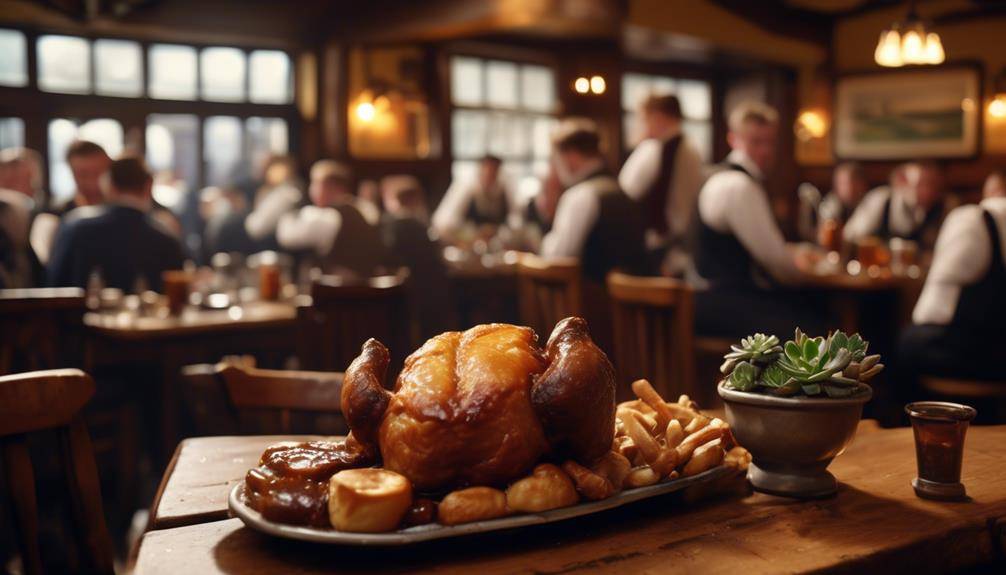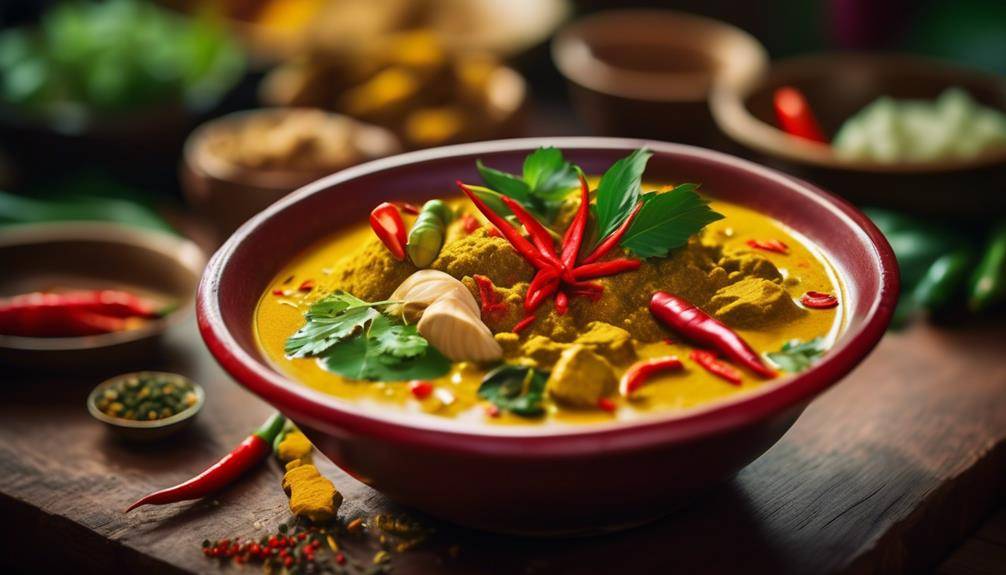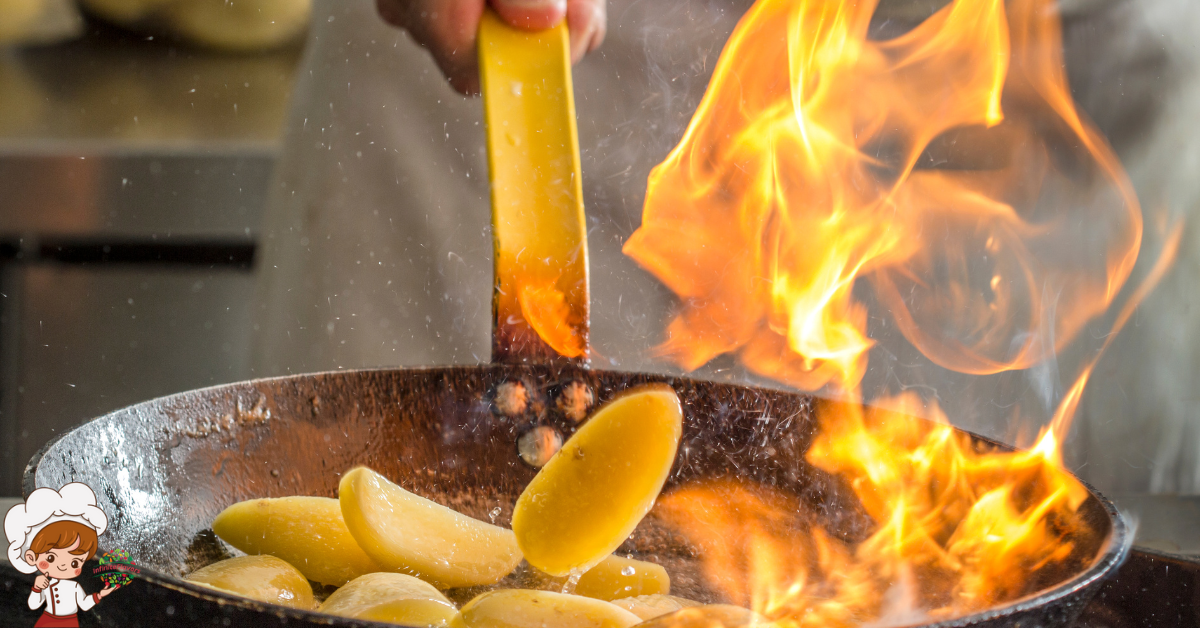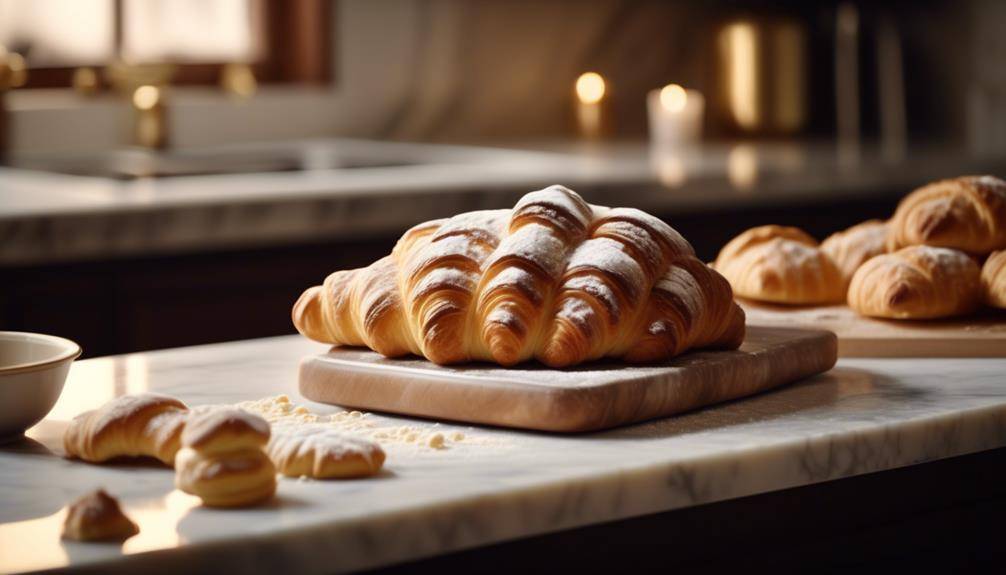The Most Unique British Food Traditions

Unique British Food Traditions; They say that food is the window to a culture’s soul, and when it comes to British cuisine, this adage couldn’t be more true. From the comforting Sunday Roast with all the trimmings to the delicate pastries of Afternoon Tea, British food traditions are as diverse as the nation itself. But what makes these traditions unique? What are the stories behind these iconic dishes? In this discussion, we will explore the rich tapestry of British food and discover the delicious secrets that have been passed down through generations. So get ready to uncover the hidden gems of British gastronomy and embark on a culinary journey like no other.
Sunday Roast and All the Trimmings
Have you ever wondered about the origins and significance of the traditional British Sunday Roast and all the delectable trimmings that accompany it? This iconic meal, which has been enjoyed by generations of Britons, is a beloved tradition that brings families together every Sunday. The Sunday Roast consists of roasted meat, usually beef, lamb, or chicken, accompanied by roasted potatoes, Yorkshire puddings, vegetables, and a rich gravy.
One interesting aspect of the Sunday Roast is the regional variations that can be found across the United Kingdom. While the basic components remain the same, each region has its own unique twist on the meal. For example, in Yorkshire, the home of the famous Yorkshire pudding, the Sunday Roast is often served with a large, fluffy Yorkshire pudding that is filled with meat and gravy. In Cornwall, the Sunday Roast may feature a Cornish pasty, a savory pastry filled with meat and vegetables.
In addition to the regional variations, the Sunday Roast also boasts a variety of cooking techniques. Traditionally, the meat is roasted in the oven, slowly cooked to perfection. This slow cooking method ensures that the meat is tender and juicy. The potatoes are roasted alongside the meat, absorbing all the delicious flavors. The Yorkshire puddings are made by pouring a batter made of flour, eggs, and milk into hot oil or drippings, resulting in a crispy and airy texture.
Afternoon Tea and Delicate Pastries
When indulging in the quintessential British tradition of Afternoon Tea, one cannot resist the allure of delicate pastries that tantalize the taste buds with their exquisite flavors and intricate designs. Afternoon Tea is a time-honored ritual that dates back to the 19th century, when it was popularized by Anna, the Duchess of Bedford. It typically involves a selection of teas, served alongside a delectable assortment of finger sandwiches, scones, and, of course, delicate pastries.
Delicate finger sandwiches are an essential component of Afternoon Tea. These bite-sized treats are typically made with thinly sliced bread and filled with an array of savory fillings such as cucumber and cream cheese, smoked salmon, or egg and cress. The sandwiches are meticulously crafted, with crusts removed and the fillings evenly spread. The result is a dainty and elegant treat that perfectly complements the tea.
In addition to the finger sandwiches, delicate pastries are a highlight of Afternoon Tea. These miniature confections are a feast for the eyes as well as the palate. From intricately decorated petits fours to flaky and buttery tarts, each pastry is a work of art. Traditional favorites include the Victoria sponge cake, made with layers of sponge cake filled with jam and cream, and the classic fruit tart, adorned with seasonal fruits and a glossy glaze.
When enjoying Afternoon Tea, it is important to observe traditional tea etiquette. The tea should be brewed properly and served in beautiful china cups. The pastries and finger sandwiches should be arranged on a tiered stand, with the sandwiches on the bottom, followed by the scones, and finally the delicate pastries on top. It is customary to start with the sandwiches, then move on to the scones, and finish with the pastries. And, of course, one must remember to always extend their pinky finger while sipping the tea.
Fish and Chips – a British Classic
Now let’s talk about the historical origins and traditional cooking methods of Fish and Chips, a beloved British classic. You’ll discover the fascinating journey of this iconic dish, tracing back to the 19th century when it gained popularity among working-class communities. From the bustling fish markets to the sizzling hot fryers, the process of making Fish and Chips has remained largely unchanged, ensuring a crispy golden exterior and tender flaky fish that has stood the test of time.
Historical Origins
The historical origins of Fish and Chips, a beloved British classic, can be traced back to the 19th century. This iconic dish was influenced by historical factors that played a significant role in shaping its cultural significance. The popularity of fish as a staple food in coastal regions, coupled with the availability of cheap potatoes during the Industrial Revolution, contributed to the rise of this culinary tradition.
The advent of railways and the expansion of the fishing industry allowed for the widespread distribution of fresh fish across the country. This accessibility, combined with the affordability and simplicity of the dish, made it a favorite among the working class. Fish and Chips became synonymous with British culture, symbolizing comfort, tradition, and national pride. Its historical origins have left an indelible mark on British cuisine, securing its place as a cherished culinary tradition.
Traditional Cooking Methods
To prepare the quintessential British dish of Fish and Chips, a traditional cooking method is employed to achieve the perfect balance of crispy batter and tender fish. This method has been passed down through generations and holds cultural significance in British cuisine. Here are some traditional cooking techniques used in making Fish and Chips:
- Deep-frying: The fish is coated in a seasoned batter and then deep-fried in hot oil until golden and crisp. This method ensures a crunchy exterior while maintaining the delicate texture of the fish.
- Double-frying: After the initial frying, the fish is removed from the oil, allowed to rest, and then fried again for a shorter time. This technique creates an extra crispy coating while keeping the fish moist and flavorful.
- Drying: To achieve the desired texture, the fish is often dried before frying. This step helps remove excess moisture, resulting in a lighter and less greasy final product.
These traditional preservation techniques not only contribute to the taste and texture of Fish and Chips but also reflect the cultural heritage of British cuisine.
Full English Breakfast – a Hearty Start to the Day
Get ready to satisfy your morning hunger with a hearty Full English Breakfast. This iconic meal is renowned for its generous portions and diverse range of ingredients. From crispy bacon and sausages to grilled tomatoes and eggs, the Full English Breakfast offers a symphony of flavors that can vary depending on regional preferences. Explore the ingredients, historical origins, and regional differences of this beloved British breakfast tradition.
Ingredients and Variations
For a hearty start to your day, indulge in the rich and satisfying flavors of a Full English Breakfast, complete with a variety of traditional ingredients and tantalizing variations. This iconic British dish consists of several key components that come together to create a truly delicious meal. The ingredients typically include bacon, sausages, eggs, baked beans, tomatoes, mushrooms, and toast.
However, there are also regional and personal variations that add a touch of uniqueness to this classic dish. Cultural influences play a significant role in shaping these variations, with ingredients such as black pudding, haggis, and fried bread making appearances in different parts of the country. Whether you prefer a traditional Full English Breakfast or enjoy exploring the different regional variations, this dish is sure to satisfy your taste buds and fuel you for the day ahead.
Historical Origins
The historical origins of the Full English Breakfast can be traced back to the 13th century when it was known as a ‘groaty pudding’. This traditional dish consisted of a porridge-like mixture made from grains, vegetables, and meat. Over time, the ingredients and preparation methods evolved to include staples such as bacon, eggs, sausages, tomatoes, mushrooms, and toast.
The Full English Breakfast gained popularity among the working class in the 19th century as it provided a hearty and substantial meal to start the day. Its cultural significance lies in its association with British identity and the idea of a fulfilling breakfast that sets one up for the day ahead. Today, the Full English Breakfast remains a celebrated tradition and is enjoyed by locals and tourists alike.
Regional Differences
As we explore the regional differences of the Full English Breakfast, it becomes apparent that this hearty start to the day varies in its components and preparation methods across different parts of Britain. The regional variations of the Full English Breakfast are influenced by cultural factors that have shaped the culinary traditions of each area.
- In the North of England, the Full English Breakfast often includes black pudding, a blood sausage that adds a rich and savory flavor to the meal. Additionally, fried bread is a common feature in this region, providing a crispy and indulgent element to the breakfast.
- In the Midlands, the Full English Breakfast may feature oatcakes, a type of pancake made with oats, which adds a unique texture and taste to the dish.
- In Scotland, regional variations include the addition of haggis, a traditional Scottish dish made from sheep’s offal, oatmeal, and spices. This addition adds a distinctive and robust flavor to the breakfast.
These regional variations highlight the diverse cultural influences that have shaped the Full English Breakfast across different parts of Britain.
Eccles Cakes and Other Regional Treats
Eccles cakes and other regional treats hold a special place in British food traditions, with their distinct flavors and rich history. When it comes to regional desserts in Britain, traditional baking methods play a crucial role in creating these delectable treats.
One of the most famous regional desserts in Britain is the Eccles cake. Originating from the town of Eccles in Greater Manchester, these small, round cakes are made with flaky pastry filled with a mixture of currants, sugar, and spices. The traditional baking method involves rolling out the pastry thinly, adding the filling, and then folding and crimping the edges to seal in the deliciousness. The cakes are then baked until golden brown, resulting in a crispy exterior and a sweet, gooey center. The combination of textures and flavors is what makes Eccles cakes so irresistible.
Another regional treat that is worth mentioning is the Bakewell tart from the town of Bakewell in Derbyshire. This dessert consists of a shortcrust pastry base, a layer of jam, and an almond-flavored sponge filling. The tart is baked until the filling is set and the pastry is golden. The traditional baking method ensures that the tart has a crisp crust and a moist, almond-infused filling, creating a perfect balance of flavors.
In Cornwall, the Cornish pasty is a beloved regional treat. These handheld pies have a distinctive D-shaped design and are filled with a mixture of beef, potatoes, onions, and swede. The pasties are then baked until golden brown, resulting in a hearty and satisfying meal. The traditional baking method involves crimping the edges of the pasty to create a seal and prevent any filling from escaping during baking.
These regional treats showcase the diversity and creativity of British baking traditions. From the flaky layers of an Eccles cake to the crisp crust of a Bakewell tart, these desserts are a testament to the skill and craftsmanship of British bakers. Whether you are a fan of sweet or savory treats, exploring the world of regional British desserts is sure to be a delightful and mouth-watering experience.
Cornish Pasties – a Portable Delight
Get ready to sink your teeth into the flaky goodness of Cornish pasties. These handheld delights are a true British tradition, loved for their perfect combination of a buttery, crisp pastry and a hearty, savory filling. The traditional meat filling, made with chunks of beef, potatoes, onions, and swede, provides a comforting and satisfying taste that will leave you craving for more.
Flaky Pastry Pockets
Flaky pastry pockets, known as Cornish pasties, are a delectable and convenient treat that can be enjoyed on the go. These traditional British delicacies have a rich history and cultural significance. Here are some key points to understand about Cornish pasties:
- Ingredients and techniques:
- Cornish pasties are typically made with a filling of diced beef, potatoes, onions, and swede (turnip).
- The pastry is made using a combination of flour, butter, and water, resulting in a flaky and buttery crust.
- The filling and pastry are seasoned with salt and pepper, creating a savory and flavorful combination.
- Cultural significance:
- Cornish pasties have a deep-rooted history in Cornwall, England, where they were traditionally enjoyed by miners for their portability and nourishment.
- The distinctive D-shape of the pasty is said to have originated from the miners’ habit of holding the crimped edge, preventing them from eating the lead-contaminated crust.
- Symbolism:
- The crimped edge of the pasty served a practical purpose of sealing in the filling, but it also became a symbol of Cornish identity and craftsmanship.
- Cornish pasties were granted protected status by the European Union in 2011, recognizing their cultural significance and ensuring their authenticity.
These flaky pastry pockets are not only a delicious snack but also a symbol of Cornwall’s rich mining heritage and culinary traditions.
Traditional Meat Filling
The traditional meat filling of Cornish pasties, a portable delight, is a delectable combination of diced beef, potatoes, onions, and swede, encased in a flaky and buttery pastry crust. This classic filling has remained largely unchanged over the years, although there are some regional variations in the ingredients used.
Traditional recipes often call for skirt or chuck steak, which is cut into small cubes and mixed with diced potatoes, onions, and swede. The ingredients are seasoned with salt and pepper, and sometimes a touch of thyme or parsley for added flavor. The mixture is then carefully placed onto rolled-out pastry dough and folded over to create a half-moon shape. The edges are crimped to seal in the savory goodness, and the pasties are baked until golden brown. This meat filling is a staple of Cornish cuisine and continues to be a beloved treat for locals and visitors alike.
Handheld Comfort Food
Indulge in the handheld comfort of Cornish pasties, a portable delight that combines a flaky and buttery pastry crust with a delectable filling of diced beef, potatoes, onions, and swede. These regional comfort foods have been enjoyed in Cornwall for centuries and are now popular throughout the UK. Here’s why Cornish pasties have become a beloved treat:
- The pastry: Made with a mixture of flour, butter, and water, the pastry is rolled out thinly and then folded over the filling, creating a sturdy and delicious casing for the savory ingredients.
- The filling: The unique flavor combinations of diced beef, potatoes, onions, and swede create a hearty and satisfying meal in one bite. The ingredients are seasoned with salt and pepper, providing a burst of flavor with every mouthful.
- Portability: Cornish pasties were originally made for miners to take to work, and their handheld nature makes them the perfect grab-and-go snack.
With their rich history, mouthwatering flavors, and convenient nature, Cornish pasties continue to be a beloved handheld comfort food in the UK.
Black Pudding – Love It or Hate It
Black Pudding, whether you adore its unique flavor or despise its unconventional ingredients, is a divisive dish that sparks passionate debate among British food enthusiasts. The controversy surrounding its ingredients and the cultural significance it holds make it a truly intriguing part of British food traditions.
Black pudding is a type of blood sausage made using a mixture of pig’s blood, fat, oatmeal, and various spices. The inclusion of blood as a key ingredient has been a subject of controversy for many. Some find the idea of consuming blood unappealing, while others appreciate the rich, earthy flavor it imparts to the pudding. This clash of opinions has led to heated discussions and debates among food enthusiasts.
Despite the ingredients controversy, black pudding has a strong cultural significance in British cuisine. It has been a part of British food culture for centuries and is often associated with traditional English breakfasts. The dish is also celebrated in various regional festivals and events, like the World Black Pudding Throwing Championship in Ramsbottom. Its long-standing presence in British culinary history has cemented its place as a beloved and iconic dish.
Black pudding’s unique flavor and cultural significance have made it a polarizing dish. While some appreciate its distinct taste and historical significance, others are put off by its unconventional ingredients. Nevertheless, the passionate debates surrounding black pudding only serve to highlight its importance in British food traditions. Whether you love it or hate it, black pudding continues to hold a prominent place in the hearts and palates of British food enthusiasts.
Yorkshire Pudding – the Perfect Accompaniment
If you’re looking for the perfect accompaniment to a traditional British roast dinner, Yorkshire pudding is an absolute must-have. With its light and fluffy texture, golden brown exterior, and rich flavor, this iconic dish has become synonymous with British cuisine. But what are the historical origins and traditional cooking techniques that make Yorkshire pudding so special?
- Historical Origins:
- Yorkshire pudding dates back to the 18th century and originated in Northern England, specifically Yorkshire. It was originally served as a first course to fill up hungry diners before the main meal.
- The dish gained popularity due to its simplicity and affordability. It was made with basic pantry staples such as flour, milk, and eggs, making it accessible to all social classes.
- Over time, Yorkshire pudding became associated with Sunday roast dinners, where it was traditionally served alongside roasted meats, vegetables, and gravy.
- Traditional Cooking Techniques:
- The key to achieving the perfect Yorkshire pudding lies in the batter and the cooking process. The batter is made by whisking together equal parts flour, eggs, and milk until smooth and free of lumps.
- To ensure a light and airy texture, the batter should be rested for at least 30 minutes before cooking. This allows the gluten in the flour to relax, resulting in a tender pudding.
- The traditional cooking technique involves preheating a baking dish with beef drippings or vegetable oil until smoking hot. The batter is then quickly poured into the hot dish, causing it to sizzle and rise.
- The Yorkshire pudding is cooked in a hot oven until it has risen and turned golden brown. The final result is a crispy exterior with a soft and custard-like center.
Crumpets and Tea – a Quintessentially British Pairing
After savoring the delectable Yorkshire pudding, it’s time to explore another quintessentially British pairing – crumpets and tea. Traditional British tea etiquette is an essential part of this cherished tradition. When it comes to tea, the British have a set of rules that govern the proper way to enjoy this hot beverage. First and foremost, the tea should be served in fine china cups, accompanied by a saucer. The cup is held with the thumb and index finger, while the middle finger supports the handle.
Now, let’s turn our attention to the star of the show – the crumpets. These beloved treats are a type of griddle cake made from a simple batter of flour, yeast, and milk. They are cooked until golden brown and have a soft and spongy texture. Crumpets are typically served toasted and buttered, with the butter melting into the small holes on the surface. The combination of the crisp exterior and the fluffy interior is simply heavenly.
While the classic crumpet is a staple, there are also variations of this delightful treat. Some people prefer to add raisins or currants to the batter, giving the crumpets a sweet and fruity flavor. Others enjoy spreading jam or marmalade on top, adding a burst of tanginess to each bite. No matter the variation, crumpets are always best enjoyed alongside a piping hot cup of tea.
Haggis – a Scottish Delicacy
Haggis, a traditional Scottish delicacy, is a dish that may not be for the faint of heart, but its rich history and unique flavors make it a must-try for any adventurous food lover. This iconic dish is deeply rooted in Scottish cuisine and holds significant cultural significance. Here are three reasons why haggis stands out among other dishes:
- Historical Origins: Haggis has been a staple in Scottish cuisine for centuries. Its origins can be traced back to the 15th century, making it a dish with a long and fascinating history. Traditionally, haggis was made using sheep’s pluck, which includes the heart, liver, and lungs, mixed with oats, onions, and spices. The mixture is then stuffed into a sheep’s stomach and cooked. While the ingredients and methods may vary slightly today, the essence of haggis remains true to its historical roots.
- Unique Flavors: The combination of ingredients in haggis creates a flavor profile that is both distinctive and delicious. The richness of the organ meats, the nuttiness of the oats, and the subtle spiciness of the seasoning blend together to create a harmonious and savory taste. The cooking process further enhances the flavors, resulting in a dish that is hearty and comforting.
- Cultural Significance: Haggis holds a special place in Scottish culture and is often associated with celebrations and gatherings. It is traditionally served on Burns Night, a commemoration of the Scottish poet Robert Burns, where it is accompanied by neeps and tatties (mashed turnips and potatoes). Haggis is also a symbol of Scottish identity and is proudly showcased as a national dish. Its cultural significance extends beyond Scotland, as it has become synonymous with Scottish cuisine worldwide.
Unique British Food Traditions; Frequently Asked Questions
What Is the History Behind the Sunday Roast and How Did It Become a British Tradition?
The history of the Sunday roast and its evolution into a British tradition is fascinating. It originated as a meal enjoyed by the upper class, but eventually became a beloved weekly tradition for all social classes.
Can You Provide Some Information on the Origins of Afternoon Tea and How It Became Popular in Britain?
Afternoon tea originated in the early 1840s in England. It became popular among the British upper class as a social event. The etiquette includes serving tea with finger sandwiches, scones, and pastries.
What Are the Different Variations of Fish and Chips Found Across the Uk?
In the UK, you’ll find various variations of fish and chips. From gluten-free options to regional toppings, there’s something for everyone. Traditional versions remain popular, but modern interpretations and health-conscious alternatives are also gaining traction.
How Did the Full English Breakfast Come About and What Are the Key Components That Make It a Hearty Start to the Day?
The full English breakfast originated in the late 19th century and has become a classic British morning meal. Its key components include bacon, eggs, sausages, baked beans, mushrooms, tomatoes, and toast. It’s a hearty start to the day.
Are There Any Unique Regional Treats in Britain That Are Not Commonly Known Outside of the Country?
Did you know that Britain is home to a variety of regional delicacies and lesser known British desserts? From the Cornish pasty to the Bakewell tart, there are plenty of unique treats to discover!
Conclusion
In conclusion, British food traditions are a unique and diverse mix of flavors and culinary delights. From the comforting Sunday Roast with all the trimmings to the delicate pastries and tea of Afternoon Tea, these traditions showcase the rich history and cultural heritage of the British Isles. Whether you love or hate Black Pudding or enjoy a hearty Full English Breakfast, these iconic dishes continue to be cherished and celebrated throughout the country. So, next time you’re in Britain, don’t miss the opportunity to indulge in these delicious and quintessentially British delights.








